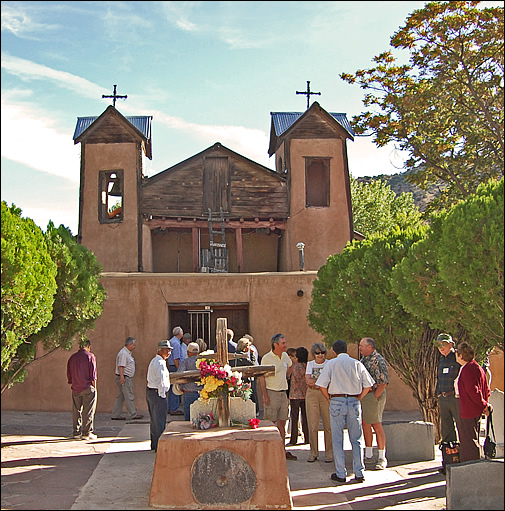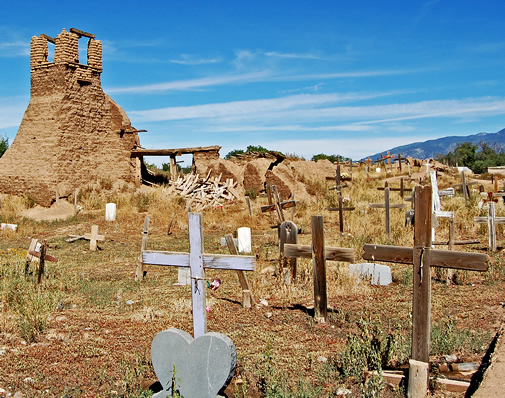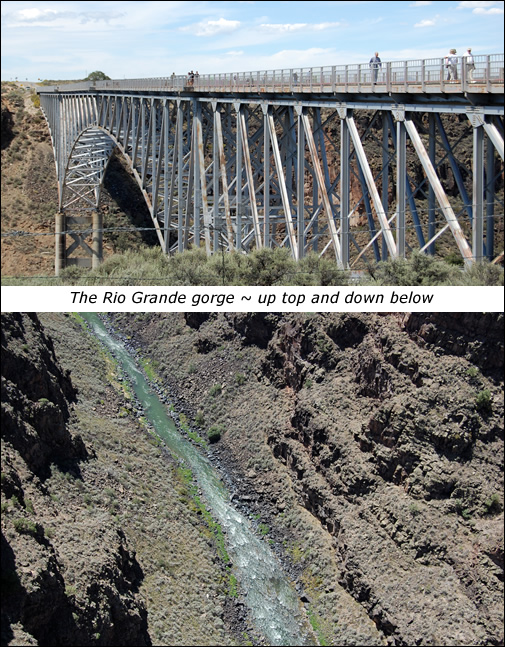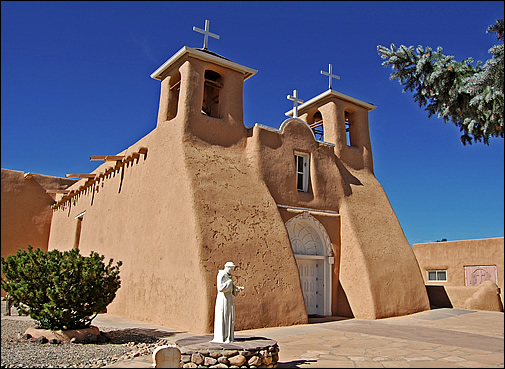|
The soothing waters at Chimayo in New Mexico
Santa Fe and Points North:
'The Land of Enchantment'
By Ron Fritze from Athens, Alabama
Posted on September 24, 2010
Actually, of course, Texas is no bigger than New Mexico.
It only appears bigger because it is spread out so much thinner.
The mean average thickness of New Mexico
from sunshine to sea level is 5000 feet.
The higher you go into the mountains the meaner it gets . . . .
Mashed down and rolled out to the same thickness as Texas,
New Mexico would reach all the way
from Yalta to the Atlantic Charter
with enough lapover to flap in the Texas wind.
— S. Omar Barker (1947)
Twylia and I just returned from our first visit to New Mexico and it was quite a pleasant experience. Mr. Barker, whoever he was — John Gunther quoted him in Inside the U.S.A — was right about the thicker. Santa Fe is about 6,500 feet thick, and our field trip to Taos took us over 7,500 feet above sea level. We did not have any real problems with the altitude, although I noticed it every time I climbed some stairs.
As usual we flew out of Huntsville and changed planes at Dallas for an American Eagle flight to Santa Fe. Some people fly to Albuquerque and take a shuttle to Santa Fe, but I liked the idea of a direct connection. The American Eagle service into Santa Fe is relatively new. Snoozing on the plane, I awoke as we neared Santa Fe and found myself looking down into a valley with a highway running through it and a long escarpment of a mesa running alongside it.
Society for the History of Discoveries
At the municipal airport another plane occupied on the runway, so the pilot did a loop around the city before we landed. The quaint, Adobe style airport terminal featured a neat design, sadly spoiled by the necessities of airport security. A shuttle took us to the La Fonda Hotel for the meeting of the Society for the History of Discoveries.
The La Fonda is a 1920s era hotel located just off the historic
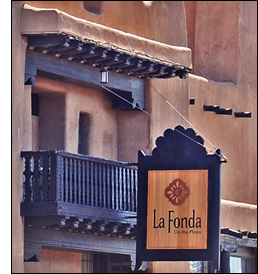 Santa Fe Plaza and, of course, built in the Adobe style. We got checked in to a very nice room. A helpful and friendly desk clerk named Gabriel recommended that we eat at a place called Tomasita’s, a bit over a half-mile walk from the La Fonda. It was only 5 p.m. but there was already a bit of a line. I took that as a good sign.
Santa Fe Plaza and, of course, built in the Adobe style. We got checked in to a very nice room. A helpful and friendly desk clerk named Gabriel recommended that we eat at a place called Tomasita’s, a bit over a half-mile walk from the La Fonda. It was only 5 p.m. but there was already a bit of a line. I took that as a good sign.
After a brief wait, we were seated and got our first look at a menu. It was not all that extensive, which concerned us. We ordered a half-liter of margaritas on the rocks — smooth and excellent. Both of us ordered a tamale and enchilada plate, and I got mine with refried beans and rice. It was all wonderful. The tamales in Santa Fe are particularly good. They are shaped like squatty rectangular boxes but with a marvelous meat filling. Ours were covered with a red chili sauce, a tad hot but very tasty. The enchiladas were seasoned with a green chili sauce, also hot but in a different way and just as flavorful. The beans were the second best I’ve ever tasted, second only to those I once enjoyed at the Hotel Menger in San Antonio.
Just in Time for Fiesta
We arrived in Santa Fe during their Fiesta, which is a celebration of the recapture of Santa Fe after the great rebellion of the Pueblo Indians in 1680. It’s a joyous day for our Hispanic fellow citizens and a day of sorrow for our Pueblo fellow citizens. The Fiesta occupied the Santa Fe Plaza, which was full of food vendors, bands, and fiestinistas. The food was typical festival fare — funnel cake, turkey legs, etc. Celebrations ended Sunday, so we also got to see the Plaza in its normal bucolic state of walkways, benches, and a great big gazebo.
Santa Fe was a Spanish outpost with considerable stocks of silver, wool, and mules. Unfortunately, the outpost suffered from an aggravating shortage of manufactured goods. Trade goods from Mexico followed a circuitous route through hundreds of miles of territory inhabited by ferocious bands of Apaches. As a result, manufactured products were scarce and extremely expensive.
Word of Santa Fe’s plight attracted the attention of French Canadian traders in 1739. Coming overland from the Missouri River, they discovered that Santa Fe was reasonably accessible. More French traders followed and by 1804 Americans were joining them. Spanish authorities reacted by imprisoning foreign merchants who interloped on Spain's monopoly of trade with its empire. When Mexico gained its independence in 1821, Santa Fe was thrown open to American traders.
The Santa Fe Trail
William Becknell, an Indian trader, was the first American to reach the now welcoming inhabitants of Santa Fe. He and others that followed developed a route that crossed over some 780 miles of prairie. Although the first traders used packhorses, wagons could easily travel the Santa Fe Trail as there were only a few rivers that needed crossing. Much of the trail followed the course of the Arkansas
 River. Initially the trail began at Franklin, Missouri, but its eastern terminus moved first to Independence and eventually to Kansas City.
River. Initially the trail began at Franklin, Missouri, but its eastern terminus moved first to Independence and eventually to Kansas City.
Traders traveling the Santa Fe Trail soon began to band together in caravans for mutual protection from Indian attack, although the Indians seldom attacked. Between 1821 and 1842 only eleven men were reported killed along the trail by Indians. Violence escalated at the end of the Civil War during the years 1864-1869. The worst year was 1868 when it was reported that forty-five people had perished on the trail, including seventeen stagecoach passengers burned to death by Indians.
In spite of such incidents, the Santa Fe Trail was heavily used throughout its history. Thousands of wagons rolled along the trail each year with many continuing on to California. Trade with Santa Fe supplied the United States with significant amounts of much needed silver and mules. Progress rendered the trail obsolete with the completion of the Atchison, Topeka, and Santa Fe Railroad in 1880.
Members of the Society visit Santuario de Chimayo
In the Embrace of the Shepherd
The next day, Sunday, we joined a bus tour sponsored by the Society for the History of Discoveries — destination Taos. Leaving Santa Fe and heading north, our bus took the route known as the High Road. As you might imagine, it passes through a highland area. Our first stop was a place called Chimayo. It contains a Catholic chapel built in 1816, the Santuario de Nuestro Señor de Esquipulas, commonly known as the Santuario de Chimayo. A pilgrimage site, the Santuario is renowned for soil that is purported to possess healing powers. I can’t speak to the power of the soil, but the area is lovely, graced by towering mountains and swift streams, green pastures and large trees. Seeing Chimayo brought Psalm 23 to mind,
The Lord is my Shepherd;
I shall not want.
He maketh me to lie down in green pastures:
He leadeth me beside the still waters.
Actually, the waters at Chimayo are babbling brooks, providing the soothing sound of water running down a creek bed.
After Chimayo our bus took us to Taos Pueblo. I was under the mistaken belief that Taos Pueblo was an archaeological site. It is actually a functioning community of the Northern Tiwa tribe of the Pueblo people that dates back possibly as far as 1000 AD.
The cemetery at Taos Pueblo ~ September 12, 2010
The Ultimate Price for Resistance
Taos Pueblo was at the center of covert planning by Native Americans that resulted in the Pueblo Revolt of 1680. When the Spanish reconquered the area, the Taos Pueblo suffered some significant damage. A second devastation occurred during the Mexican-American War in 1847 when United States forces attacked the Pueblo on the assumption its people were supporting Mexico. Some one hundred and fifty Tiwas were killed in the attack and the Pueblo’s church was destroyed. Its grounds were used to bury the dead. The site of the old church serves as the Pueblo’s cemetery today.
Like Chimayo, the Taos Pueblo has a nice little river, the Rio Pueblo, flowing through it, but I like Chimayo better.
How High Is Scary?
Next we headed to the gorge of the Rio Grande, a deep slash in the earth, ripped through a flat basin surrounded by mountains. Where we visited, the gorge is 750 feet deep. Approaching it is reminiscent of the landscape in the final scenes of Thelma and Louise, very flat ground with a big surprise dead ahead. You would not know the gorge is there until you are right on top of it.
After crossing a big steel bridge, the bus left us off to take a look. I hurried out to take pictures. Not fond of high places, Twylia stayed on the bus. I was approaching the center of the bridge when I suddenly realized that passing trucks were making the bridge shake. Frankly, I don’t like high structures. The shaking reminded me that I was not standing on solid earth but on a human structure. So, as my tummy turned and my legs turned to jelly, I got my pictures and rushed off the bridge. Very impressive but also scary if you don’t like heights.
Our lunch at the retirement home of some Society for the History of Discoveries members was a nice stop and the food was good. They have a beautiful house. Twylia liked it because it did not have books all over the place. She was wrong, though. Two rooms were filled with books from floor to ceiling. My kind of place. They also had a pretty garden where I learned about yarrow, which has a great aromatic smell and lovely blossoms. I was taken by an impressive paprika yarrow with reddish flowers. Now I want to grow some. Based on what I have read, yarrow will grow in Alabama. Needless to say, it is drought resistant.
Our next stop was Taos. I told Twylia to look out for Marshall McCloud. She told me to . . . well, I don’t want to disillusion anyone about the limits of her ladylike qualities. Taos has a nice plaza, though smaller than Santa Fe’s. Twylia and I went for a drink and she got some soft tacos at some second-story restaurant. The quality of the food and drink could not match Tomasita’s. I’m afraid I can’t remember the name of the place. Not bad, but no Tomasita’s.
San Francisco de Asis Church
One of Ms. O'Keeffe's Favorites
At that point we board the bus and started back to Santa Fe. A little outside of Taos, we stopped at San Francisco de Asis Church, made famous by Georgia O’Keeffe. By the standards of Spanish architecture in the Southwest, the structure is not that old, having been constructed between 1772 and 1815. But it is a lovely church. O’Keeffe was right to single it out for praise and attention.
On Monday the conference of the Society started in earnest with a reception and dinner. Monday was full of sessions with interesting papers. We even had a demonstration of traditional Maya chocolate, which I will tell you more about in my next essay. Monday evening was the Society banquet with a great lecture from Richard Flint on the Coronado expedition. Flint is probably the foremost historian of the Coronado expedition, so he brought up lots of interesting and unique points in his talk.
The next day, after morning meetings, we found time for lunch at The Shed, which also serves Mexican food. The place appears to be run by a bunch of gringos but the food was good anyway — and again, not as good as Tomasita’s. I gather the locals like the place, just as they also like Tomasita’s. We both ordered blue corn tacos and enchiladas covered with a red chili sauce. Neither place was expensive either, although on the whole, Santa Fe is not a cheap town. And we even had time for a drink at the La Fonda. I tried an Alien Amber Ale from Roswell. It was actually good.
After that we caught the shuttle back to the airport and made our way safely back home. It was a good trip and we got to reunite with other members of the Society for the History of Discoveries, who are a very pleasant group of people. Will we go back to Santa Fe? Yes! It is definitely worth a visit. And a second. And a third.

Click on the black panther to read about Ron Fritze's latest book,
Invented Knowledge: False History, Fake Science, and Pseudo-religions. |



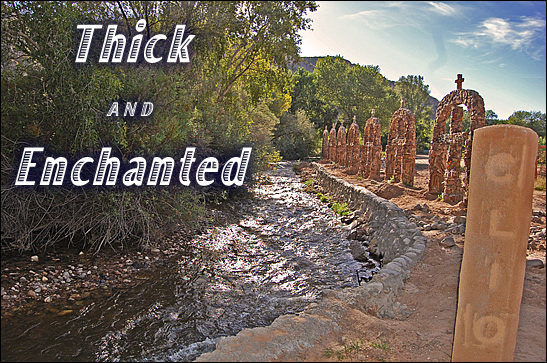
 Santa Fe Plaza and, of course, built in the Adobe style. We got checked in to a very nice room. A helpful and friendly desk clerk named Gabriel recommended that we eat at a place called Tomasita’s, a bit over a half-mile walk from the La Fonda. It was only 5 p.m. but there was already a bit of a line. I took that as a good sign.
Santa Fe Plaza and, of course, built in the Adobe style. We got checked in to a very nice room. A helpful and friendly desk clerk named Gabriel recommended that we eat at a place called Tomasita’s, a bit over a half-mile walk from the La Fonda. It was only 5 p.m. but there was already a bit of a line. I took that as a good sign. River. Initially the trail began at Franklin, Missouri, but its eastern terminus moved first to Independence and eventually to Kansas City.
River. Initially the trail began at Franklin, Missouri, but its eastern terminus moved first to Independence and eventually to Kansas City.